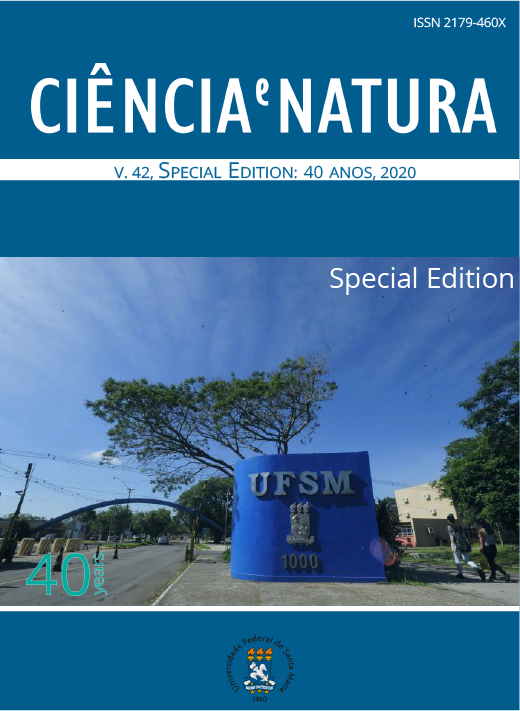Modal waves in multiconductor transmission lines by using fundamental matrix response
DOI:
https://doi.org/10.5902/2179460X40992Palavras-chave:
Multiconductor transmission lines, Fundamental matrix solution, Junction in transmission lines, Circulant matrix, Impedance and admittance matricesResumo
The differential equations that model voltage and current for a multiconductor transmission line are written in matrix form. Supposing a time exponential solution through of the modal analysis the modal waves are obtained and solution of a ordinary matrix differential equation, thus determining the amplitude for voltage and current. The modal waves are given in terms of the fundamental matrix solution associated to the ordinary matrix differential equation. The decomposition of the modal waves in forward and backward propagators are used for determine the reflection and transmission matrices for junction in transmission lines. Circulant symmetric transmission lines are discussed, case in that the values for the self-impedance are the same as well as the mutual-impedance values and the same considerations to the admittance matrix. In particular, for these transmission lines are characterized the propagation constants and is observed that the number of multiconductors has effects only on a specific propagation constant. Numerical example of one multiconductor transmission line is presented allowing to observe important aspects of the methodology developed.
Downloads
Referências
Amirhosseini, M. K., Cheldavi, A. (2003). Time domain analysis of circulant symmetric coupled transmission lines. IEE Proc-Microw Antennas Propag, 150(5), 325–331.
Carrier, G. F., Krook, M., Pearson, C. E. (2005). Functions of a Complex Variable: Theory and Thechinique. Society for Industrial and Applied Mathematics.
Claeyssen, J. R., Canahualpa, G., Jung, C. (1999). A direct approach to second-order matrix non-classical vibrating equations. Applied Numerical Mathematics, 30(1), 65–78.
Davis, P. J. (1979). Circulant Matrices. John Wiley & Sons, Inc., USA.
Dmitriev, V., Portela, G., Martins, L. (2018). Temporal coupled-mode theory of electromagnetic components described by magnetic groups of symmetry. IEEE Transactions on Microwave Theory and Techniques, 66(3), 1165–1171.
Heydt, G. T., Pierre, B. J. (2016). Sequence impedances for high phase order power transmission systems. Em: 2016 IEEE/PES Transmission and Distribution Conference and Exposition, pp. 1–5.
King, R. W. P. (1965). Transmission-line Theory. Dover Publications, Inc.
Knockaert, J., Peuteman, J., Catrysse, J., Belmans, R. (2009). General equations for the characteristic impedance matrix and termination network of multiconductor transmission lines. Em: IEEE International Conference on Industrial Technology, ICIT 2009, pp. 1–6.
Nitsch, J., Baum, C. E., Sturm., R. (1992). Analytical treatment of circulant nonuniform multiconductor transmission lines. IEEE Transactions on Electromagnetic Compatibility, 34(1), 28–38.
Pandya, A. (2008). Multi-phase power system: performance analysis & design. Thesis, Doctor of Philosophy in Electrical Engineering, Department of Electrical Engineering, Maharaja Sayajirao University of Baroda.
Papaleonidopoulos, I. C., Theodorou, N. J., Capsalis, C. N. (2013). Travelling-wave modelling of uniform multi-conductor transmission line networks - part i: Analytical derivation. Progress In Electromagnetics Research B, 52, 253–293.
Paul, C. R. (2008). Analysis of multiconductor transmission lines, 2o edn. John Wiley & Sons, Inc.
Triverio, P., Grivet-Talocia, S., Chinea, A. (2010). Identification of highly efficient delay-rational macromodels of long interconnects from tabulated frequency data. IEEE Transactions on Microwave Theory and Techniques, 58(3), 566–577.
Wagenaars, P., Wouters, P. A. A. F., van der Wielen, P. C. J. M., Steennis, E. F. (2010). Measurement of transmission line parameters of three-core power cables with common earth screen. IET Science, Measurement & Technology, 4(3), 146–155.
Willems, J. L. (1989). A new approach to the analysis of mixed three-phase and six-phase power systems. International Journal of Electrical Power & Energy Systems, 11(2), 115–122.
Downloads
Publicado
Como Citar
Edição
Seção
Licença
Para acessar a DECLARAÇÃO DE ORIGINALIDADE E EXCLUSIVIDADE E CESSÃO DE DIREITOS AUTORAIS clique aqui.
Diretrizes Éticas para Publicação de Revistas
A revista Ciência e Natura está empenhada em garantir a ética na publicação e na qualidade dos artigos.
A conformidade com padrões de comportamento ético é, portanto, esperada de todas as partes envolvidas: Autores, Editores e Revisores.
Em particular,
Autores: Os Autores devem apresentar uma discussão objetiva sobre a importância do trabalho de pesquisa, bem como detalhes e referências suficientes para permitir que outros reproduzam as experiências. Declarações fraudulentas ou intencionalmente incorretas constituem comportamento antiético e são inaceitáveis. Artigos de Revisão também devem ser objetivos, abrangentes e relatos precisos do estado da arte. Os Autores devem assegurar que seu trabalho é uma obra totalmente original, e se o trabalho e / ou palavras de outros têm sido utilizadas, isso tem sido devidamente reconhecido. O plágio em todas as suas formas constitui um comportamento publicitário não ético e é inaceitável. Submeter o mesmo manuscrito a mais de um jornal simultaneamente constitui um comportamento publicitário não ético e é inaceitável. Os Autores não devem submeter artigos que descrevam essencialmente a mesma pesquisa a mais de uma revista. O Autor correspondente deve garantir que haja um consenso total de todos os Co-autores na aprovação da versão final do artigo e sua submissão para publicação.
Editores: Os Editores devem avaliar manuscritos exclusivamente com base no seu mérito acadêmico. Um Editor não deve usar informações não publicadas na própria pesquisa do Editor sem o consentimento expresso por escrito do Autor. Os Editores devem tomar medidas de resposta razoável quando tiverem sido apresentadas queixas éticas relativas a um manuscrito submetido ou publicado.
Revisores: Todos os manuscritos recebidos para revisão devem ser tratados como documentos confidenciais. As informações ou ideias privilegiadas obtidas através da análise por pares devem ser mantidas confidenciais e não utilizadas para vantagens pessoais. As revisões devem ser conduzidas objetivamente e as observações devem ser formuladas claramente com argumentos de apoio, de modo que os Autores possam usá-los para melhorar o artigo. Qualquer Revisor selecionado que se sinta desqualificado para rever a pesquisa relatada em um manuscrito ou sabe que sua rápida revisão será impossível deve notificar o Editor e desculpar-se do processo de revisão. Os Revisores não devem considerar manuscritos nos quais tenham conflitos de interesse resultantes de relacionamentos ou conexões competitivas, colaborativas ou outras conexões com qualquer dos autores, empresas ou instituições conectadas aos documentos.






